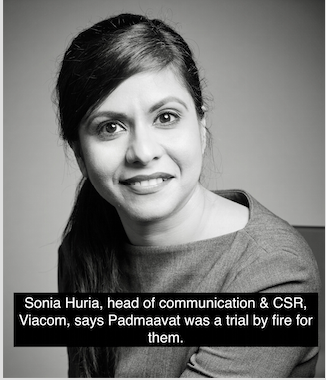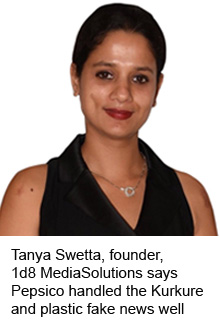How Viacom 18 fought the Padmaavat fake news controversy
PR Insight
Paarul Chand
Early this year, protests against the Sanjay Leela Bhansali directed magnum opus, Padmaavat, reached a crescendo. Just ahead of the movie’s release, violent political protests against the film , chiefly fanned by the Rajput Karni Sena on the supposed depiction of Rajputs in Padmaavat broke out.
States such as Rajasthan, Haryana, Gujarat, Madhya Pradesh, notably all BJP ruled states banned the release of the film.
With months of intense creative effort and crores of rupees locked in the film, it was a nightmarish situation for any moviemaker.
The Padmaavat Fightback
Says, Sonia Huria, head-communications & CSR, Viacom18 which produced Padmaavat, “Right from the production phase, the movie fell prey to fake news and a web of deliberate misinformation.  This agenda driven propaganda found a life of its own across both traditional and new-age media.”
This agenda driven propaganda found a life of its own across both traditional and new-age media.”
The misinformation stemmed around the allegation that there was a love scene between Padmawati and Alahuddin Khilji. As a result, the director of the film was even attacked on the sets of the film and the sets vandalised.
Huria shares that in order to combat this, “Our stakeholder engagement strategy turned into a living organism…in a constant state of evolution! From a typical, if unconventional, marcom strategy during the pre-production phase, it quickly turned into one that involved fighting fake news and proactively run an awareness campaign highlighting the truth of the movie’s content. The objective was to build the right perception about the film, not just amongst the audiences but also amongst those who influenced them – the media – through constant education about the film and what it stood for.”
Viacom 18 also built support for the film by reaching out to noted historians, personalities from within the film fraternity and various persons and organisations who were willing to look beyond the negativity and delve into the truth.
Outlining the impact of the communications campaign, Huria says, “Luckily for us, the more the misinformation campaign spread, the more people started realising the ludicrousness of it. When the country’s institutions - Central Board for Film Certification and the Hon’ble Judiciary – cleared the film, it was the moment of truth for us.”
After what Huria describes as a “Trial by fire for Viacom18 Motion Pictures, that began in early 2017 with the release of a fake news piece”, finally ended with Padmaavat clocking gross India box office collections of INR 300 crores. Huria says she learnt a lot from this experience of fighting fake news ,“There is nothing that amplifies your voice more than the right set of influencers.”
Huria also adds that more importantly, “We should have faith in the country’s institutions. Our processes are robust.”
Are Brands Fighting back?
Given the instant viral nature of anti-brand fake news, are their fighting back?
Girish Balachandran, founder 'On Purpose', puts it bluntly, “Mostly, they aren’t. Fighting fake news requires a solid listening and monitoring process to be able to catch falsehoods, lies and propaganda often masqueraded as news, before it goes viral. Most brands in India use listening tools as lip-service and only react to it after it’s hit mainstream press. The smart ones are building their own platforms as go-to places for media and stakeholders to verify what is true or not. It allows them to control the narrative, reduce the chances of being caught off-guard with vandalised content and present their side of the story to a well curated audience.”
Examples of this are properties such as Flipkart stories that presents their news and features directly to the consumer audience.
 While admitting that fighting social media based fake news is a tough proposition due to sheer speed with which it spreads, Tanya Swetta, founder & joint managing director of id8 Media Solutions says it can be done.
While admitting that fighting social media based fake news is a tough proposition due to sheer speed with which it spreads, Tanya Swetta, founder & joint managing director of id8 Media Solutions says it can be done.
Swetta elaborates on her experience with a client, “We have several examples of successful crisis management. Fake news isn't limited to intentionally misleading news or a mistake but it could also be twisting facts and amplifying them to get more viewership and readership. It could also be the claims of another party which are being printed without a journalist doing their research. In one instance, a religious group attacked our client and while some of the claims were valid, the organization kept harassing them by spreading rumours even after amends were made to get publicity out of the incident. We had to ensure that the media understood the complete situation through one on one meetings with them and then slowly they stopped giving their claims any importance.”
Plastics in Kurkure
One of the most successful brand management of fake news is of the persistent rumour that the popular PepsiCo India snack ‘ Kurkure’ has plastic.
This fake news that first began in 2008 took several years to counteract.

Swetta says, “I remember the time Kurkure was attacked for allegedly containing plastic. Kurkure had to endure the constant suspicion from customers and people that there might be plastic present within the chips. Besides uploading a caution notice on their website stating that the chips are completely safe, PepsiCo hosted an event where young women bloggers could come and view the production process for themselves and record if anything out of order or suspicious was happening.”
Adds Swetta, “ The team then got an authority like AIIMS to also certify the product and confirm that there was no plastic used in the manufacturing of the product. I believe the brand handled the situation very accurately. “
PepsiCo also redesigned their package to state that the snack was made from dal, corn and rice, a fact that the consumer should have been aware off right off the bat though.
Now one does not hear this bit of fake news
The Padmaavat and Kurkure stories shows how easily a brand can become a target of malicious fake news. Vivek Rana, CEO, The PRactice says in this video byte that fake news is here to stay due to the very nature of human beings:
The only way to counteract this is by active listening and accepting that fake news is not going away anytime soon.
If you enjoyed this article, you can subscribe for free to our weekly event and subscriber alerts.
Featured

PR professionals share their views on journalists publicly calling them out on story pitches

Auto blogger renders unconditional apology to Value 360 for defamatory posts

Hottest Indian startups of 2020, Paytm, Dreams 11 lead the charge: Wizikey Report




